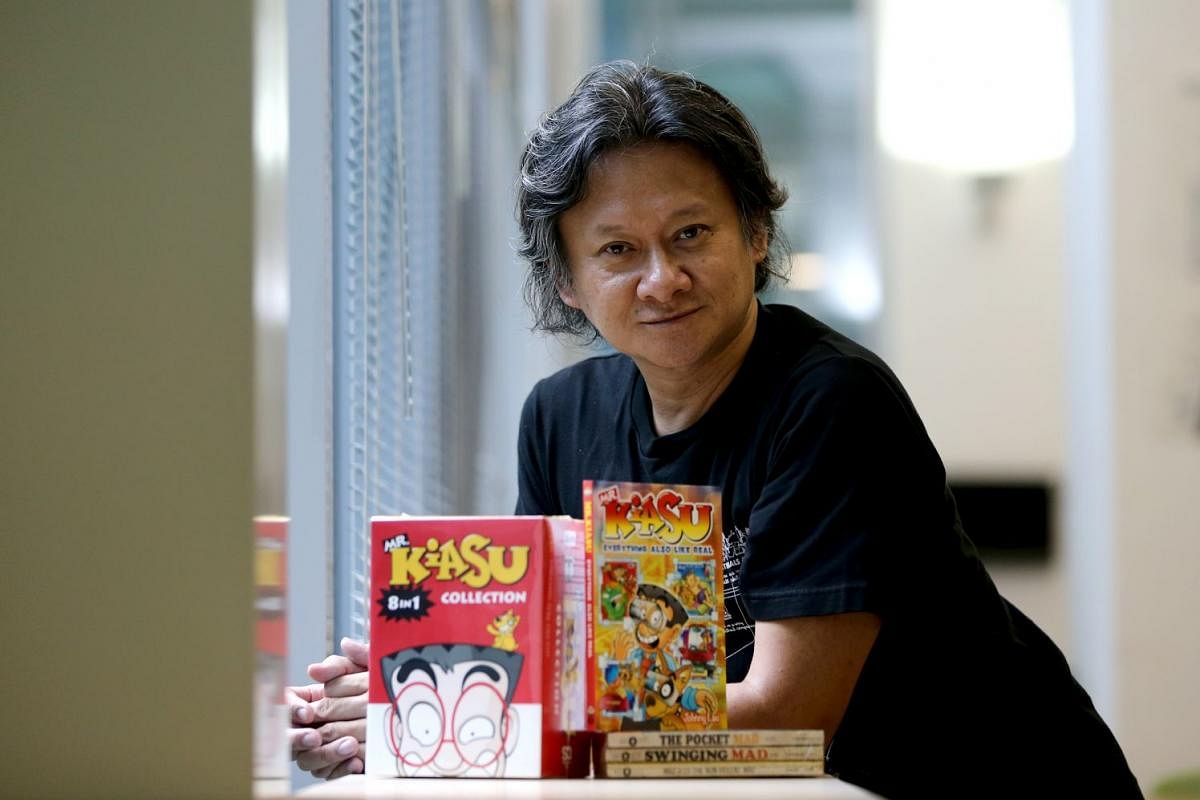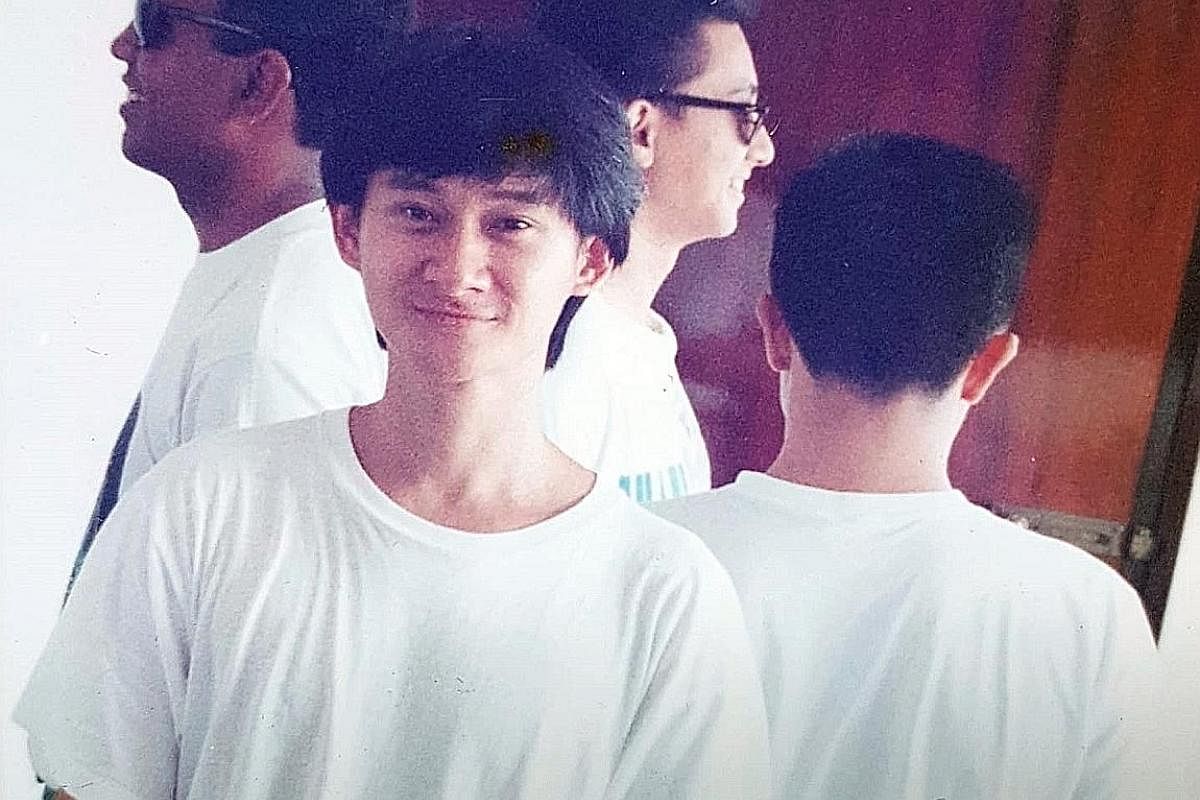The Life Interview With Johnny Lau
Johnny Lau is the opposite of his creation Mr Kiasu
The comic character’s creator Johnny Lau self-funded his first book after every publisher turned him down


Johnny Lau tells a story about how he is misunderstood.
Once, he was at a book fair signing copies of his comic book, Mr Kiasu. The title character embodies the Singaporean trait of hating to lose and going to ludicrous lengths to be No. 1.
"This woman was standing in the queue. A long queue, but she had no book in her hand," says Lau, 54, who is working on a movie version of the comic.
When she came face-to-face with him, she told him that she was a teacher. His instincts kicked in. "I automatically stood up and said, 'Yes, teacher!'"
Her students were fans of his books, she said, and he was infecting her students with Singlish. Furthermore, the books spread the image of the Ugly Singaporean abroad. "She scolded me for 15 minutes," he recalls.
Lau explained to her that the books do not rely on Singlish. There is an occasional "lah" and, sometimes, characters might shorten "Where is it?" to "Where?", he allows.
But everything else is standard English and that rule has held since the first book was published in 1990, he says.

Readers also assume that Mr Kiasu is just Lau looking at himself.
"I'm actually the opposite of him," he says. The risk-averse character would never have done as the artist did: He self-funded the first book after every publisher turned him down. If that book had failed at its launch at the 1990 Singapore Book Fair, he would have owed creditors thousands of dollars.
And Mr Kiasu would never leave money on the table. Eighteen years ago, after the release of the eighth book, Lau decided to end the series while it was still popular.
At the genesis of the project, he warned the original team - James Suresh, Eric Chong and Lim Yu Cheng - that he saw only a 10-year lifespan for the series.
He remembers them laughing because "nobody thought we would survive past book one".
The books not only survived, but also sparked a craze that in 1993 spawned a McDonald's Kiasu Burger (more than a million sold over a two-month period), spin-off comics, a television series, a radio show and a stage musical.
The character would be splashed on towels, T-shirts and watches, available at the brand's own outlet at the Takashimaya shopping mall.
Then Lau put everything on ice in 1999.
Seeking other creative outlets, he plunged into a series of projects - teaching and mentoring, distributing comics, making mobile-phone software, creating comics with others, curating and designing.
One of the people he met in that period was Mr Toru Miura, 64, a Tokyo-based anime producer. They worked together on new titles as well as distributing Japanese titles in Singapore. The two have since become good friends.
Speaking on the telephone from Tokyo, Mr Miura describes Lau as someone with a curious nature.
"He is an artist, but he is also interested in producing all kinds of new content."
He attributes that to Lau's upbringing. He grew up completely at home with English and Mandarin, and loved both Asian and American comics.
During the in-between years, everywhere that Lau went, his most famous character's shadow was there.
He would be introduced as a speaker at some art event and the emcee would mention Mr Kiasu.
He does not mind that his name is now inextricably linked with that of his fictional creation and is grateful for everything the books have done for him, he tells The Straits Times.
We are chatting at the News Centre building in Toa Payoh. He has brought a copy of the ninth Mr Kiasu book, Everything Also Like Real, released last September, ending the 18-year dry spell.
"Longer than The X-Files' break," he says, comparing his time off with that of the television series which returned after a long hiatus.
Lau briefly revived Mr Kiasu in 2013 in a one-off edutainment book, which was distributed as part of an information literacy campaign organised by the National Library Board (NLB).
Other requests for a Kiasu comeback have been turned down. He says he has grown used to rebuffing the advances of local companies. They want to reprint old books or want him to create new ones.
But Lau has crossed paths with them before and is less than impressed.
"They were the same people who slammed the door in my face when I showed them my first book," he says.
Then, Shogakukan Asia came along. The relative newcomer to the region is an arm of leading Japanese publishing firm Shogakukan Inc.
The company treats creators with respect, says Lau. It is serious about marketing his books overseas, especially in Japan, where comics are mass entertainment.
It has re-released the first eight titles individually and is now taking pre-orders for a limited-run box set containing all eight volumes.
He saw comedy in Singaporeans' me-versus-them mindset
Lau's cautiousness comes from experience. An over-ambitious merchandising venture launched at the height of the 1990s Kiasu craze led to losses and contributed to a falling out between Lau and former collaborator Suresh.
In 2013, letters from Suresh, Chong and Lau were published in the Today newspaper over the issue of authorship, after a Today article about the NLB project mentioned only Lau, leaving out the others.
In their letters, Chong and Suresh said Mr Kiasu's final shape was a group effort, a fact that Lau acknowledged in his letter. No one disputed the fact that it was Lau who first conceived the character.
In the foreword of last year's Mr Kiasu book, Lau acknowledges all three co-authors. In fact, Lim created the cover art for it, while Chong is credited as a special adviser. Credit for story and art go to Lau, while his long-time collaborator Nick Tan is given pencil and ink credit.
Lau married in 1995, divorced seven years later and has no children. He lives in the same multi-generation bungalow in Katong in which he grew up. He has a younger sister who works as an administrator in an educational institute.
He has great admiration for, and developed a closeness to, his maternal grandfather, Mr Ngo Pit Cheong, a businessman who came here from China and spoke only Hokkien.
Not only was he self-made, but he was also generous to a fault with friends and family, says Lau.
Lau was born in London because his parents were students of music there at the time.
They returned to Katong, after which the house was filled with students and the tinkling of pianos. His parents turned part of the house into a music school; his father later became a businessman.
As a boy, Lau devoured everything from Hong Kong-made martial arts comics to American works, especially Mad magazine. He especially loved the freewheeling publication's caricatures and movie parodies.
He taught himself to sketch cartoons. Egged on by classmates, he drew grotesque versions of teachers, which got him into trouble. But he could not stop.
"I don't know why. It's a curse. I would go, 'Wah, that teacher is so ugly, I have to draw him,'" he says.
American superhero comics had little appeal for him because they have "too many words". "One speech balloon can take up an entire panel," he complains.
After Maris Stella High School, he moved on to the University of Southern California, where he enrolled in a course that satisfied his parents' desire for him to have a respectable career and also tapped his gift for art - architecture.
He went on to make the dean's list for academic excellence, despite throwing himself into extra-curricular arts courses from glass-blowing to ceramics.
Back in Singapore, he received a medical downgrade because of asthma, so for national service, he worked as a graphic artist at Pioneer magazine. There, he met Lim, Chong and Suresh, who were also in uniform at the time.
Lau wanted to do a parody in the style of Mad magazine and saw endless comedy possibilities in the Singaporean habit of seeing everything, no matter how mundane, as a me-versus-them contest.
His father was aghast at his son's decision to ditch architecture for comics. Then the first book sold out its first print run of 3,000 copies, shattering the myth that a local comic could never be a mass seller. His father breathed easier after that and, ever since, has supported Lau's career.
Since the first Mr Kiasu book, dozens of locally produced comic titles have appeared, including copycats, but none has had the same market impact. Including crossover titles, combined sales of Mr Kiasu books have exceeded the 400,000 mark.
These days, Lau is busy with promoting his newest book around the region. He also draws a regular comic strip for Chinese-language newspaper Lianhe Zaobao (which he has been doing since 2012) while working on the next Mr Kiasu book, the 10th.
He is an executive producer on the Mr Kiasu movie, to be released next year by production house mm2 Entertainment. Lau says he is involved in nearly every creative department: story, cast, music and even wardrobe.
His creation, the cheeky bloke not above taking shortcuts to success, might have got him into trouble with teachers in the 1990s. Today, the kids who smuggled his books into school are in their 30s.
He gets a kick out of seeing grown-up faces light up at a serious business meeting when he gets recognised.
"Someone will introduce me and the mood will suddenly change. They will go, 'Are you sure?' and then 'Can I take a picture with you?'.
"The books are in the psyches of so many people now. I know the books did well, but it takes moments like that for me to realise how much of an influence they have been."
Join ST's Telegram channel and get the latest breaking news delivered to you.
A version of this article appeared in the print edition of The Straits Times on July 02, 2018, with the headline Johnny Lau is the opposite of his creation Mr Kiasu. Subscribe

